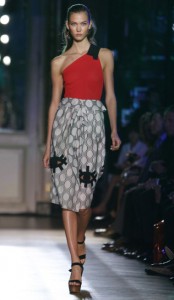



Everyone left the Christian Dior SS ’12 show with the same lasting memory – Karlie Kloss’s backside. Imprinted in our thoughts forever. Not to say that it was the only memorable thing about the collection, but in a flimsy transparent veil it undoubtedly closed the show.
For the past six months, talk about Dior has only been about who’s next? Which big name designer will take up the reins of this luxury juggernaught? But spare a thought for the designer who is in the meantime responsible for turning out some clothes. Bill Gaytten worked with Galliano for twenty years, and, temporarily, the house is in his hands. His couture collection was widely panned by critics in July, which may explain the slight reserved feeling about the ready-to-wear. Don’t get me wrong, the clothes were pretty, some beautiful and others exquisite, but Gaytten has pulled Dior back to basics. Tailoring? Check. Trapeze coats? Check. Enough evening gowns to dress the world’s rich and fabulous? Check, check, check. But there was something a bit apologetic about it all. Although maybe it’s just that for the first time in a long time the crowd has actually imagined themselves wearing Dior, as Galliano’s interpretations were so theatrical, so over the top – I can’t say I miss his ‘acting’ models (nothing worse by the way) – whereas Gaytten’s Dior is about the clothes, not about outrageous make-up and styling. And I quite liked that.
It also means that whoever is to be announced as the new Creative Director has a blank canvas to work with, because Gaytten has proved to be the Dior palette cleanser and there’s nothing wrong with that.
As the temperature rises in Paris, Christian Dior plays it safe post-Galliano, Lanvin brings dark magic, and Lady Gaga’s friends at Mugler fail to break away from costumes. Robin Givhan reports on the runways’ best.
Two kinds of designers tend to take on Paris Fashion Week: those who believe their technique is so refined that it can stand alongside this city’s history of fantastical haute couture; and those who believe that clothes can aspire to lofty poetry, energetic polemics, and something more profound than trends, comfort, and the status quo.
So as the spring 2012 collections are unveiled in France’s capital, the eye is forced to jump from the runways of Christian Dior—with its prestigious cultural history—to the sweet melancholy of Rick Owens. The two collections could not be more different: one aiming to exude wealth (and continuity in the midst of corporate upheaval) and the other shunning any appearance of suburban comfort or bourgeois ease.
Thankfully, there is a label in Paris that simply refuses to fit neatly into such unyielding categories: Lanvin. But then again, there is also a designer that doesn’t even seem to know which is the business end of a needle and thread: Nicola Formichetti at Mugler.
Christian Dior designer Bill Gaytten had a near Sisyphean task in creating a spring 2012 ready-to-wear collection. Gaytten has been installed as interim designer for the brand since its executives fired high-profile creative director, John Galliano, after his booze-fueled anti-Semitic rant in a Paris bistro this spring. Gaytten had already presented a critically panned couture collection over the summer. And Friday afternoon, he was back, bracing for more abuse.
As has become tradition, a tent was constructed in the courtyard of the prestigious Rodin Museum. Outside, the sidewalks were lined with agitated fashion enthusiasts, straining against police barricades, intent on photographing anything in high heels as evidence of their brush with Dior. Inside, guests sat sweating shoulder-to-shoulder on the unseasonably warm Paris afternoon. The brand’s owner, Bernard Arnault, in his usual place of honor in the front row, never once seemed to raise a hand to fan himself—as if billionaires have their own internal air-conditioning system.


